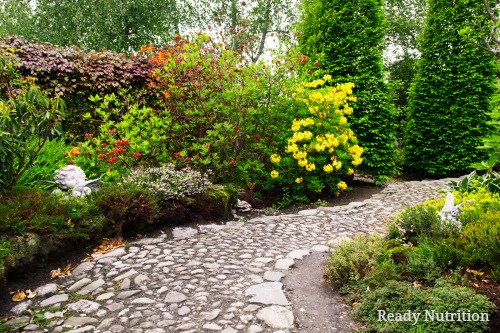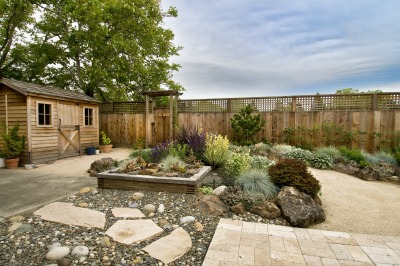60% of a person’s household water usage goes toward lawn and garden maintenance. During times of drought, our lawn and landscaping can become a bottomless pit where we are throwing away money to keep grass alive. Rather than spending exorbitant amounts of money to maintain landscaping, think outside of the box and choose a more sustainable form of landscaping.
Xeriscaping: A Low-Water Landscaping Technique
Xeriscaping is creating a sustainable system that creates regionally appropriate landscaping, conserves water and reduces your water bill. This type of landscaping is both economical and more realistic in maintaining. An added benefit is compared to typical landscaping, it can reduce landscape water use by 50-75%!
When a person thinks of xeriscaping, they think of rocks and cactus. While this may be one form of xeriscaping, it does not encompass the entire concept.
There are seven fundamental principles to xeriscaping – many of which are common sense.
7 Principles of Xeriscaping
- Good design and planning – When you change your landscaping design to a more sustainable one, you are eliminating plants that require excessive care. As well, planning how they are grouped by watering will help eliminate lost water.
- Proper soil preparation with adequate amounts of soil amendments – The ideal soil in a water-conserving landscape does two things simultaneously: it drains quickly and stores water at the same time.
This is achieved by increasing the amount of organic material in your soil and keeping it well aerated. Amendments such as compost and green sand can do wonders for conserving water. - Appropriate use of turfgrass – Reduce any unused turf in the yard, while retaining some turf for open space, functionality and visual appeal. Plan for irrigation-friendly areas of turf or use grasses that need less water.
- Group plants by water needs – Hydrozoning is when you group your plants according to their watering needs. When you do this, you are doing two things: 1.) better-protecting plants delicate root systems, and 2.) directing the water to one area. Also, consider planting shallow rooted plants under the large rooting plants to provide shade. Companion plants would be very beneficial in this sense and will have a symbiotic relationship with one another. For example, plants that require large amounts of water should be planted closest to the house and plants that require little watering can be planted farther away in the yard.
- Efficient irrigation system – Understanding the water needs of your plants and having an efficient watering system will help you conserve more water. A well-planned garden will likely consist of 3 water zones: daily watering areas, weekly watering areas and those which can be sustained by natural rainfall without additional watering. As well, knowing that when plants mature they need much less water than when they were young. Therefore, time your irrigation systems accordingly. Consider looking into new web-based remote monitoring apps, such as the ET Water Manager that is designed to help you conserve water and maintain a healthy lawn all from the convenience of your laptop.
- Mulch to retain moisture – Adding mulch to your plants will further aid water conservation. Mulch locks moisture in the soil and allows plants to use it more efficiently. This is perfect during the dog days of summer. Mulching also reduces weeds, so it makes gardening more efficient, as well. In addition, adding ground covers such as thyme, sweet woodruff, and Bishop’s weed would also be beneficial to your xeriscaping endeavors.
- Good maintenance – Low-maintenance is one of the benefits of xeriscape. Keeping the weeds from growing up through the mulch may require some attention. Thickening the layer of mulch will help. Turf areas should not be cut too short – taller grass is a natural mulch which shades the roots and helps retain moisture.
- One key to xeriscaping is using native plants. They’re most adapted to your climate and can handle extremes in weather patterns.
- Adding drought-tolerant plants will also help you conserve water. In general, these plants have leaves which are small, thick, glossy, silver-grey or fuzzy – all characteristics which help them save water.
- Adding gravel or paving stones can reduce unused turf areas and create a lovely oasis.
- As well, consider planting deciduous shade trees. This will cut summer cooling bills exorbitantly. Plant the trees on the west and east sides of the house for best results. Doing so will also let light in during the winter.
When you decide to xeriscape, you are creating a sustainable system that creates a regionally appropriate landscaping, conserves water and reduces your water bill. When this system is followed, very little maintenance needs to be done, thus leaving more time for you to sit and enjoy your life. Our current landscaping is excessive and needs to change. Simply by changing the way you look at your lawn, you can create a low-water landscape that is both practical and beautiful. Now, who doesn’t love that?
Sources:


